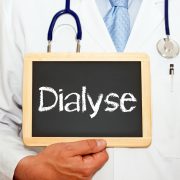End – Stage Renal Disease (ESRD) – Diversity, Mental Health Conditions, Social and Economic Impact (part 2)
Diversity and Difference in Practice
Culture, age, sexual orientation, socio-economic status and gender all must be taken into consideration when working with patients suffering from ESRD. The African-American population is four times as likely to develop ESRD compared to Caucasian individuals suffering from the same condition (Atkinson, Neu, Fivush, & Frankenfield, 2008) (Crews et al., 2010). Additionally, African-Americans have poorer intermediate outcomes when compared to Caucasians. In reference to gender, previous research shows that the outcomes for women diagnosed with ESRD are also generally poorer compared to males, especially when it comes to anemia and nutrition (Atkinson et al., 2008). If patients fail to meet their targeted goals (hemoglobin goals in particular), their risk of hospitalization and mortality rates has been shown to steadily increase (Atkinson et al., 2008).
In reference to age, research has found that African American children struggle more to reach the desired hemoglobin goals compared to Caucasian children (Atkinson et al., 2008). Additionally, the effects of low socio-economic status has been linked to African-American patients, but not Caucasian patients (Crews et al., 2010). Access to medical treatment should also be taken into consideration. Patients diagnosed with End-Stage Renal Disease have legitimate concerns when it comes to meeting Medicare Part D coverage and the gap that exists when it comes to the purchasing of dialysis related medications (Kovacs, Perkins, Nuschke, & Carroll, 2012). Since 2010 Medicare Plan D is structured in such a way as to pay for at least 75% of the first $2,830, and 95 % of the medications exceeding $6,440 in cost (Kovacs et al., 2012). The plan however provides no cost coverage for expenses that fall in-between the lower and higher spending limits. Not having access to medications due to the inability to afford them financially leads half of the studied participants in Kovacs et al.’s (2012) study to discontinue taking their medications altogether. Vocational status has been found to have an impact in reference to patients’ adjustment and coping with ESRD (Billington et al., 2008)
Mental Health Conditions and ESRD

Individuals diagnosed with ESRD are treated by an interdisciplinary team to address the issues and concerns that have. Generally, a two-fold approach is needed in order to assist clients with their physical condition as well as evaluate any potential concerns relating to their mental condition. According to Cukor (2007), patients diagnosed with ESRD receive limited psychiatric services. Billington et al. (2008) report that ESRD clients often struggle with anxiety and depression. Research shows that 20 to 30% of patients diagnosed with ESRD suffer from depression (Cukor, 2007). Depression is the second most common co-morbid disorder with ESRD patients, second only to hypertension (Cukor, 2007).
Anti-depressants are an option and even though they are safe enough for ESRD clients, medical professionals and patients themselves are generally apprehensive to add depression medications to their course of treatment (Cukor, 2007). New Selective Serotonin Reuptake Inhibitors (SSRI) have shown less aversive side effects when treating depression, however they may influence some uremic symptoms (Chilcot, Wellsted, & Farrington, 2010). Patients are generally hesitant to take anti-depressants for fear of the side effects and potential interactions with the variety of drugs they are already taking (Duarte, Miyazaki, Blay, & Sesso, 2009)
A variety of evidence-based interventions have been attempted throughout the years with the renal population. Cognitive-behavioral therapy (CBT) has been established as the leading therapeutic intervention with clients who suffer from ESRD (Duarte et al., 2009). Clients with a depressed mood typically exhibit an avoidant behavior; they lose interest in doing things and their treatment compliance decrease (Duarte et al., 2009). According to Cukor (2007), CBT is an effective approach with the ESRD clients as it attempts to address and minimize the issues they are facing, doing so in an efficient, time-limited manner.
The goal of CBT with patients diagnosed with ESRD is to assist them in modifying the activities they previously enjoyed (Cukor, 2007). Cukor (2007) reports that clients often held the negative belief that depression comes with ESRD and is “part of the package”. This view is not only erroneous but also exemplifies the dysfunctional thinking that is prevalent within this population. Cukor (2007). The CBT approach helps patients to identify this negative thought pattern and make appropriate and healthy changes in their behavior.
A study performed by Cukor (2007) shows significant reductions in the depressed mood of patients who underwent 15 weeks of individual CBT sessions. The study aimed to address the restructuring of clients’ negative thought process as well promoting behavioral activation (Cukor, 2007). The results were significant, not only at the end of the 15 week treatment program (there was a 10 point decrease on Beck Depression Inventory), but after a three month follow up the results remained steady and even dropped slightly (Cukor, 2007).
Research has also shown that joining a peer support group has been very helpful for patients suffering from ESRD. Hughes, Wood and Smith (2009) report that patients benefit greatly when they can be a part of a group where they can interact and learn about their kidney disease. Invariably the patient also gains strength from this interaction. Research performed by Patel et al., (2005) with Canadian participants show a 4.6 month delay prior to the initiation of renal replacement therapy when a social support intervention was implemented.
Although evidence-based practice is very important, timing is also key. Research has shown that the most suitable time for a psychosocial intervention is during the actual hemodialysis treatment for those patients receiving in-center dialysis (Cukor, 2007). Since hemodialysis lasts on average four hours per treatment, a portion of this time can be allocated for psychosocial interventions.
Being diagnosed with ESRD is a traumatic and often scary experience regardless of the individual’s cultural background. It should be noted that CBT has been the primary choice of treatment not only in the United States, but also in Brazil and even Taiwan (Duarte et al., 2009). For instance, renal patients in Brazil have shown significant improvement in their depressive symptoms after months three and nine when compared to the control group (Duarte et al., 2009). A study conducted in Taiwan shows that through CBT sessions ESRD patients were able to improve the quality of their sleep (Duarte et al., 2009). Hence, this treatment modality has shown effectiveness not only in the Western world, but also in countries where the quality of live and patients’ socio-economic status differs significantly when compared to the United States.
Social and economic impact

When healthcare access is limited, health disparities will be imminent (Williams, 2015). Research has established that African-American individuals are less likely to have access to medical insurance which in turn leads to less access to qualified medical care (Williams, 2015). According to Williams (2015). This inadequate access to care has been linked to an increased probability of developing chronic kidney disease. Moreover, low socio-economic status in addition to increased costs and the manner in which ESRD rapidly develops have all been attributed to delayed referrals to nephrologists (Williams, 2015).
As Nicholas, Kalantar-Zadeh and Norris (2015) reports; diabetes and hypertension are the main risk factors associated with chronic kidney disease which is believed to be attributable to ethical, racial and gender differences. In recent years however, SES has shown to have a greater influence with ESRD. For instance, a study evaluating almost 80,000 Caucasian and African-American participants found that those who made less than $15,000 a year had a 50% chance of developing ESRD (Nicholas et al., 2015). This number was 3.5 times greater for the African-American participants (Nicholas et al., 2015).
In addition to low SES, homelessness is another factor associated with developing ESRD (Nicholas et al., 2015). A study examining 15,000 individuals living in urban areas with mostly SES found that 858 of them were homeless, with high depression and rampant substance abuse. (Nicholas et al., 2015). After a three year follow up and thorough research it was determined that they had a 28% probability of acquiring ESRD and dying (Nicholas et al., 2015).
Lack of insurance is another independent risk factor that contributes to the development of ESRD especially in the low-income populations (Nicholas et al., 2015). Additionally, having health insurance does not necessarily ensure that all medical costs will be covered. For instance, Williams (2015) argues that a high deductible and high premiums are significant concerns for low-income individuals.
Individuals who are undocumented and who do not meet the eligibility criteria to enroll in a public health care exchange program generally do not have access to quality medical care (Williams, 2015). Data suggests that foreign-born residents living in the Unites states are three times as likely to not have access to insurance compared to United States residents (Williams, 2015). The same author reports that Medicaid eligibility criteria varies from state to state with foreign born residents having risk factors for ESRD and other health related disorders (Williams, 2015).
References:
Atkinson, M. A., Neu, A. M., Fivush, B. A., & Frankenfield, D. L. (2008). Disparate outcomes in pediatric peritoneal dialysis patients by gender/race in the End-Stage Renal Disease Clinical Performance Measures project. Pediatric Nephrology, 23(8), 1331-1338. doi:10.1007/s00467-008-0832-z
Billington, E., Simpson, J., Unwin, J., Bray, D., & Giles, D. (2008). Does hope predict adjustment to end-stage renal failure and consequent dialysis?. British Journal Of Health Psychology, 13(4), 683-699. doi:10.1348/135910707X248959
Blake, A., Toker, S., Dickerman, R., & Dunn, E. (2002). Trauma management in the end-stage renal disease patient. The American Surgeon, 68(5), 425.
Brown, E. A., & Johansson, L. (2011). Epidemiology and management of end-stage renal disease in the elderly. Nature Reviews Nephrology, (10), 591.
Chilcot, J., Wellsted, D., & Farrington, K. (2010). Depression in End-Stage Renal Disease: Current Advances and Research. Seminars In Dialysis, (1), 74.
Crews, D. C., Charles, R. F., Evans, M. K., Zonderman, A. B., & Powe, N. R. (2010). Original Investigation: Poverty, Race, and CKD in a Racially and Socioeconomically Diverse Urban Population. American Journal Of Kidney Diseases, 55992-1000. doi:10.1053/j.ajkd.2009.12.032
Cukor, D. P. (2007). Use of CBT to Treat Depression Among Patients on Hemodialysis. Psychiatric Services, (5), 711. doi:10.1176/ps.2007.58.5.711
Duarte, P. S., Miyazaki, M. C., Blay, S. L., & Sesso, R. (2009). Cognitive–behavioral group therapy is an effective treatment for major depression in hemodialysis patients. Kidney International, 76(4), 414-421. doi:10.1038/ki.2009.156
Hackett, A. S., & Watnick, S. G. (2007). Withdrawal from Dialysis in End-Stage Renal Disease: Medical, Social, and Psychological Issues. Seminars In Dialysis, 20(1), 86-90. doi:10.1111/j.1525-139X.2007.00249.x
Hughes, J., Wood, E., & Smith, G. (2009). Exploring kidney patients’ experiences of receiving individual peer support. Health Expectations: An International Journal Of Public Participation In Health Care & Health Policy, 12(4), 396-406. doi:10.1111/j.1369-7625.2009.00568.x
Jansen, D. L., Heijmans, M., Rijken, M., & Kaptein, A. A. (2011). The development of and first experiences with a behavioural self-regulation intervention for end-stage renal disease patients and their partners. Journal Of Health Psychology, 16(2), 274-283. doi:10.1177/1359105310372976
Kovacs, P. p., Perkins, N., Nuschke, E., & Carroll, N. (2012). How End-Stage Renal Disease Patients Manage the Medicare Part D Coverage Gap. Health & Social Work, 37(4), 225-233
Low, J., Smith, G., Burns, A., & Jones, L. (2008). The impact of end-stage kidney disease (ESKD) on close persons: a literature review. NDT Plus, 1(2), 67-79. doi:10.1093/ndt-plus/sfm046
Nicholas, D. B., Picone, G., & Selkirk, E. K. (2011). The lived experiences of children and adolescents with end-stage renal disease. Qualitative Health Research, 21(2), 162-173. doi:10.1177/1049732310382789
Nicholas, S. B., Kalantar-Zadeh, K., & Norris, K. C. (2015). Article: Socioeconomic Disparities in Chronic Kidney Disease. Advances In Chronic Kidney Disease, 22(Socioeconomics, Disparities, and the Kidney), 6-15. doi:10.1053/j.ackd.2014.07.002
Patel, S. S., Peterson, R. A., & Kimmel, P. L. (2005). The Impact of Social Support on End-Stage Renal Disease. Seminars In Dialysis, 18(2), 98-102. doi:10.1111/j.1525-139X.2005.18203.x
Wells, J. R., & Anderson, S. T. (2011). Self-Efficacy and Social Support in African Americans diagnosed with End Stage Renal Disease. ABNF Journal, 22(1), 9-12 4p.
Wells, J. R., & Walker, C. A. (2012). Factors Influencing Adherence in African Americans with End Stage Renal Disease. Journal Of Theory Construction & Testing, 16(2), 52-56.
Williams, A. W. (2015). Article: Health Policy, Disparities, and the Kidney. Advances In Chronic Kidney Disease, 22(Socioeconomics, Disparities, and the Kidney), 54-59. doi:10.1053/j.ackd.2014.06.002














I like your writing style truly loving this web site.